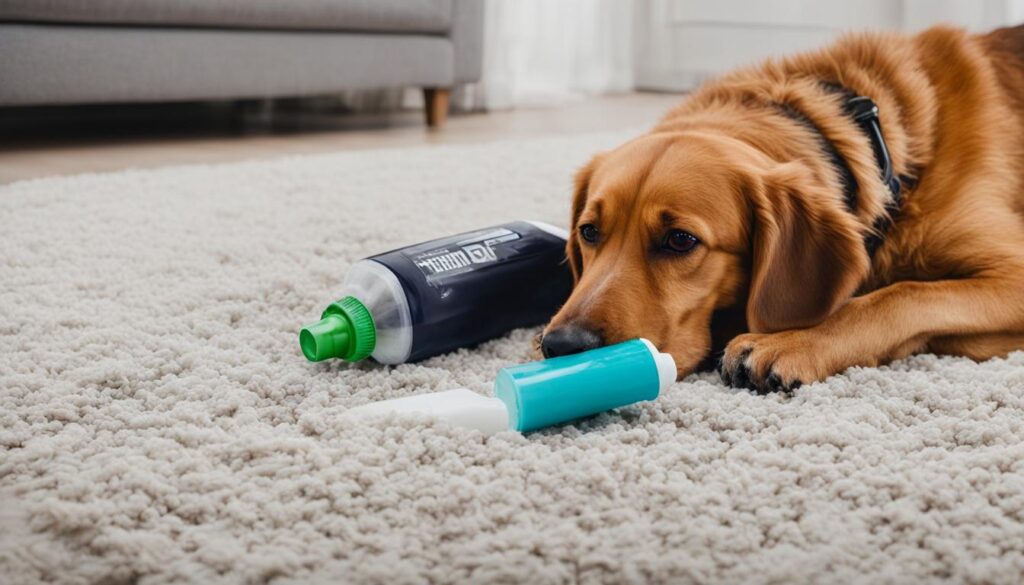As a dog owner, it’s essential to be vigilant and proactive when it comes to identifying and preventing fleas in your furry friend. Fleas are common external parasites that feed off the blood of dogs, causing discomfort and potential health issues. Dog flea infestations can be challenging to treat, but with the right knowledge and preventive measures, you can keep your dog flea-free and happy.
Checking your dog for fleas is the first step in early detection and treatment. Fleas can be picked up from other infested animals or environments. It’s important to be aware of the signs that indicate your dog may have fleas. Scratching, skin irritation, fur loss, and the presence of tapeworms are some of the common symptoms your dog may exhibit in case of a flea infestation.
Detecting fleas on dogs can be done through various methods. Visual inspection of your dog’s fur, checking for flea dirt, and setting up a flea trap are some effective ways to identify fleas. Regularly examining your dog’s skin and observing any unusual behavior or symptoms will help you catch the problem early.
Key Takeaways:
- Fleas are external parasites that feed off dogs’ blood and can cause discomfort and health issues.
- Common signs of flea infestation in dogs include scratching, skin irritation, fur loss, and the presence of tapeworms.
- Methods to detect fleas on dogs include visual inspection, checking for flea dirt, and setting up a flea trap.
- Early detection and treatment of fleas are crucial to preventing further complications.
- Regularly examining your dog’s skin and observing any unusual behavior or symptoms can help identify fleas.
How to Check Your Dog for Fleas

When it comes to keeping your dog free from fleas, early detection is key. Regularly checking your dog for fleas is important to prevent flea infestations and ensure your pet’s well-being. Here are some effective methods to check if your dog has fleas:
- Visual Inspection: Start by visually inspecting your dog’s skin, particularly in thinly-furred areas like the abdomen and hindquarters. Look for tiny, fast-moving insects or dark specks that resemble dirt. These dark specks are actually flea droppings, also known as flea dirt.
- Flea Comb: Use a flea comb, a specially designed comb with fine teeth, to comb through your dog’s fur. Pay close attention to the base of the tail, behind the ears, and around the neck. As you comb through, check for any live fleas or flea dirt that gets caught in the comb.
- White Towel Test: Another effective method is the white towel test. Brush or rub your dog’s coat on a white towel. If you see tiny black specks falling onto the towel, it could be flea dirt. These specks will turn red when wet, as they are digested blood.
If you notice any of these signs during your dog’s inspection, it is likely that your dog has fleas. Additionally, if your dog displays symptoms such as persistent itching, scratching, red pimples, or bumps, it could be a sign of flea allergies. Flea allergies can cause discomfort and irritation in dogs, so it’s crucial to address the issue promptly.
Flea Allergies in Dogs
Itching, scratching, red pimples, or bumps are signs of flea allergies in dogs.
If you suspect that your dog has flea allergies or a flea infestation, it is important to consult with your veterinarian. Your veterinarian can provide proper diagnosis and recommend appropriate flea treatment options, including topical products, oral medications, and other treatment methods.
Remember, early detection and prompt treatment are essential for keeping your dog flea-free and ensuring their overall health and well-being.
Symptoms of Fleas in Dogs

Fleas can cause various symptoms in dogs, indicating their presence and infestation. It is important to recognize these symptoms to take prompt action and protect your furry friend from the discomfort and potential health issues caused by fleas.
Common Symptoms
- Itching and scratching: One of the most common signs of fleas in dogs is excessive itching and scratching. Dogs may scratch their bodies, particularly around the neck, ears, armpits, and groin areas.
- Skin irritation: Flea bites can lead to skin irritation, redness, and inflammation. Dogs may develop small red bumps or experience generalized skin redness and sensitivity.
- Scabs and lesions: Intense scratching due to fleas can cause scabs and open lesions on the skin. These areas may be sore and prone to infection.
- Fur loss: Prolonged flea infestations and persistent itching can result in fur loss in dogs. Bare patches or thinning areas of fur may be visible.
- Tapeworm infestation: Fleas can transmit tapeworms to dogs. If your dog has fleas, they may also have tapeworms. Look for small, white, rice-like segments in your dog’s feces or around their anus.
- Anemia: In severe cases of flea infestation, dogs, especially young puppies, can develop anemia. Anemia is characterized by pale gums, weakness, lethargy, and lack of appetite.
Health Risks and Diseases
Fleas not only cause discomfort but can also transmit diseases to dogs. Some of the diseases carried by fleas include:
- Plague: Fleas can carry the bacteria that cause the plague and transmit it to dogs.
- Cat scratch fever: Fleas can carry Bartonella bacteria, which can cause cat scratch fever in dogs.
If you notice any of these symptoms or suspect your dog has fleas, it is important to take immediate action. Consult your veterinarian for proper diagnosis and treatment to alleviate your dog’s discomfort and prevent further health issues.
How to Treat Your Dog for Fleas

Treating fleas requires a combination of methods to ensure effective eradication. There are various flea treatment options available, including topical products, such as spot-on liquids, flea pills, and flea collars.
Topical flea treatments, like spot-on liquids, are applied directly to your dog’s skin. They work by killing and repelling fleas, preventing infestations. These products are easy to use and provide long-lasting protection against fleas.
Flea pills for dogs are another effective treatment option. These oral medications are designed to kill fleas when ingested. They are often fast-acting, providing relief from fleas within a few hours. It is important to follow the recommended dosage and consult with a veterinarian before administering any oral medications to your dog.
Flea collars are another popular choice for flea control. These collars contain active ingredients that repel and kill fleas. They are worn around your dog’s neck and provide continuous protection against fleas. Make sure to choose a collar that is specifically designed for flea control and follow the manufacturer’s instructions for proper use.
It is also important to address any flea-related conditions that may arise in your dog. Fleas can cause itching, skin infections, and even transmit tapeworms. To treat these conditions, additional treatments may be necessary, such as antibiotics for skin infections or deworming medication for tapeworms.
Consulting a veterinarian is highly recommended for personalized recommendations and guidance. They can provide you with the most suitable flea treatment options based on your dog’s individual needs and ensure that the treatment plan is effective and safe.
Remember, treating your dog for fleas is not a one-time event. Regularly monitoring for fleas and using preventive measures is essential in maintaining a flea-free environment and the well-being of your furry friend.
See the table below for a comparison of different flea treatment options:
| Flea Treatment Option | Method of Application | Efficacy | Duration of Protection |
|---|---|---|---|
| Topical Spot-on Liquids | Applied directly to the skin | High | Up to 1 month |
| Flea Pills | Oral ingestion | High | Up to 3 months |
| Flea Collars | Worn around the neck | Moderate | Up to 8 months |
As always, consult with your veterinarian to determine the best flea treatment option for your dog’s specific needs.
How to Treat Your Home and Yard

To completely eliminate fleas from your environment, it is necessary to treat both the home and yard. Here are some effective methods to ensure a flea-free environment:
Vacuuming for Fleas
Regular vacuuming is essential in removing fleas and their eggs from carpets, upholstery, and other surfaces. Pay special attention to areas where your pets spend the most time. Don’t forget to vacuum underneath furniture, along baseboards, and in corners. Dispose of the vacuum bag or empty the canister outside to prevent reinfestation.
Washing Bedding
Wash all bedding, including pet beds and blankets, in hot water to kill fleas and their eggs. Use a high-temperature setting in the dryer to ensure thorough drying and eliminate any remaining fleas. Consider using flea-repellent laundry additives for added protection.
Treating All Pets for Fleas
Treating all pets in your household is crucial to prevent the spread of flea infestations. Consult with your veterinarian to determine the most appropriate flea treatment for each pet. Use topical treatments, oral medications, or flea collars as directed to effectively eliminate fleas on your furry companions.
Yard Maintenance for Flea Prevention
Maintaining a well-mowed yard and trimming overgrown plants can help discourage flea-carrying wildlife from entering your property. Remove any debris or organic materials where fleas may thrive. Consider using nematodes, a natural parasite that preys on fleas, to control flea populations in your yard.
Professional Pest Control for Fleas
If your home and yard are heavily infested with fleas, it is advisable to seek professional pest control services. Pest control experts have the knowledge and resources to conduct thorough treatments and ensure complete eradication of fleas. Follow their recommendations for preparation and follow-up treatments to maximize effectiveness.
Remember, it may take up to three months to completely eliminate fleas from your home and yard. Continual flea prevention for your pets, regular cleaning, and proper maintenance will help keep future infestations at bay.
How to Prevent Fleas on Your Dog in the Future
Prevention is key in managing flea infestations. To ensure the well-being of your dog, it is important to implement effective flea prevention strategies. The Companion Animal Parasite Council recommends year-round flea control, especially in warm and humid climates. By consistently applying flea prevention measures, you can protect your dog from the discomfort and potential health issues associated with fleas.
There are various flea prevention products available in the market, including oral medications and topical treatments. These products are specifically designed to repel and eliminate fleas, keeping your dog safe and flea-free. One highly effective class of oral medications is the isoxazoline class, which not only prevents fleas but also targets ticks, providing comprehensive protection for your furry friend.
Regularly bathing your dog can also contribute to flea prevention. Bathing your pet with a flea prevention shampoo helps eliminate any existing fleas and their eggs, further reducing the risk of infestation. However, it is important to use products specifically formulated for dogs, as certain flea prevention products designed for cats may contain ingredients that can be toxic to dogs.
In addition to using flea prevention products and bathing your dog regularly, it is crucial to avoid flea-infested areas. Fleas are commonly found in outdoor areas such as dog parks, wooded trails, and areas frequented by other infested animals. By keeping your dog away from these high-risk areas, you can significantly reduce the chances of flea infestations.
Remember, prevention is always better than dealing with a full-blown infestation. By implementing year-round flea control, using appropriate flea prevention products, bathing your dog regularly, and avoiding flea-infested areas, you can effectively prevent fleas and keep your dog happy and healthy.
| Product | Type | Application | Duration of Protection |
|---|---|---|---|
| Product A | Oral Medication | Once a month | 30 days |
| Product B | Topical Treatment | Once a month | 30 days |
| Product C | Flea Collar | Continuous wear | 8 months |
| Product D | Topical Treatment | Once every 3 months | 90 days |
How to Tell If Your Dog Has Fleas

The presence of flea infestation in dogs can be identified through various signs. These signs include scratching, biting, or chewing the skin, skin irritation, redness, scabs, fur loss, and the presence of tapeworms. Visual inspection can be done to spot fleas on the dog’s skin, especially in thinly-haired areas. Flea bites may appear as small red bumps. Flea dirt, which is digested blood, can be seen on the dog’s skin or in their bedding. Proper inspection and observation can help confirm the presence of fleas on dogs.
| Signs of Flea Infestation | Detecting Fleas on Dogs | Identifying Flea Bites | Checking for Flea Dirt on Dogs | Visual Inspection for Fleas |
|---|---|---|---|---|
| Scratching | Visual inspection of the dog’s skin, especially in thinly-haired areas | Small red bumps on the skin | Flea dirt can be seen on the dog’s skin or in their bedding | Examining the dog’s fur for the presence of fleas |
| Biting or chewing the skin | ||||
| Skin irritation | ||||
| Redness | ||||
| Scabs | ||||
| Fur loss | ||||
| Presence of tapeworms |
How to Get Rid of Fleas on Your Dog

When it comes to eliminating fleas on your dog, there are several treatment options available. These include topical products, flea collars, and oral medications. Consult with your veterinarian to determine the most appropriate flea treatment for your dog’s specific needs.
Topical products, such as spot-on liquids or flea collars, can be highly effective in killing and repelling fleas. These products are applied directly to your dog’s skin and provide long-lasting protection against fleas. They work by targeting and eliminating fleas at various life stages.
Using topical flea treatments can help prevent a reinfestation and keep your dog protected from these pesky pests. Always follow the instructions on the product packaging and consult with your veterinarian if you have any concerns.
Oral medications, particularly those in the isoxazoline class, are another option for flea treatment. These medications work by either preventing the growth of fleas or causing their death. They are available in chewable tablets or flavored treats, making administration easy and convenient.
When using oral medications, it is important to follow the dosage instructions provided by your veterinarian. These medications are typically given monthly to ensure continuous protection against fleas.
| Treatment Option | Method of Application/Administration | Effectiveness | Duration of Protection |
|---|---|---|---|
| Topical Products (Spot-on Liquids) | Applied directly to the skin, usually between the shoulder blades or along the back | Kills and repels fleas at various life stages | 1 month or longer, depending on the product |
| Flea Collars | Worn around the neck, releasing active ingredients that repel and kill fleas | Kills and repels fleas for several months | Several months, depending on the collar |
| Oral Medications (Isoxazoline Class) | Administered orally as chewable tablets or flavored treats | Prevents the growth of fleas or causes their death | 1 month or longer, depending on the medication |
Remember, each dog is unique, and what works for one may not work for another. It is crucial to consult with your veterinarian to determine the best flea treatment option for your dog’s individual needs. They can provide personalized recommendations based on your dog’s age, weight, overall health, and lifestyle.
How to Rid Your Home of Fleas
Treating the home is crucial for complete flea eradication. To effectively eliminate fleas in the environment, it’s important to follow a comprehensive approach. Here are some steps you can take:
Vacuuming for Fleas
Start by thoroughly vacuuming all flooring in your home, including carpets, rugs, and furniture. Pay special attention to areas where your pets spend the most time. Fleas and their eggs may be hiding in these areas.
Washing Bedding
Wash all bedding, including pet bedding and your own sheets, in hot water. High temperatures can help kill fleas and their eggs. Be sure to dry them on high heat as well.
Eliminating Fleas in the Environment
Proper disposal of loose brushes, towels, or any items that may have come into contact with fleas is essential. Additionally, remove any overgrown vegetation in your yard, as this can provide a habitat for flea-carrying wildlife.
Professional Pest Control for Fleas
For thorough flea eradication, consider seeking professional pest control services. Pest control experts have the knowledge and tools to effectively eliminate fleas from your home and yard. They can provide targeted treatments and offer guidance on long-term prevention.
Remember, getting rid of fleas in your home may take time and persistence. It’s important to continue with flea prevention measures, such as regular vacuuming, washing bedding, and treating your pets with flea preventatives, to avoid future infestations.
Wrapping Up
In conclusion, flea infestations are a common problem among dogs and can lead to discomfort and health issues if left untreated. It is crucial for dog owners to stay vigilant and recognize the signs of flea infestations in order to take prompt action. Regularly checking your dog for fleas, such as through visual inspection, flea combing, and observing their symptoms, is vital in addressing flea-related problems.
Seeking veterinary care is important for proper diagnosis and treatment of flea infestations. Veterinarians can provide personalized recommendations and treatment plans based on your dog’s specific needs. Utilizing effective flea prevention methods, including year-round prevention, maintaining a clean home and yard, and avoiding flea-prone areas, is essential in managing and preventing fleas.
Remember that flea eradication may take time and effort. It is crucial to continue preventive measures even after successful treatment to ensure the well-being of your dog. By staying proactive and working closely with your veterinarian, you can effectively protect your dog from the discomfort and health risks associated with fleas.
FAQ
How can I check if my dog has fleas?
You can check your dog for fleas by visually inspecting their skin, using a flea comb, performing the white towel test, and observing any symptoms they may have.
What are the symptoms of fleas in dogs?
The symptoms of fleas in dogs include itching, scratching, skin irritation, scabs, fur loss, and the presence of tapeworms.
How do I treat my dog for fleas?
There are various flea treatment options available, including topical products, flea pills, and flea collars. It is important to consult with a veterinarian for personalized recommendations.
How do I treat my home and yard for fleas?
To treat your home and yard for fleas, you can vacuum regularly, wash bedding in hot water, and seek professional pest control treatment. Treating all pets in the household is also important.
How can I prevent fleas on my dog in the future?
Flea prevention for dogs involves year-round flea control, using flea prevention products such as topical treatments or oral medications, regular bathing, and avoiding flea-infested areas.
How can I tell if my dog has fleas?
You can tell if your dog has fleas by checking for signs such as scratching, biting, or chewing the skin, skin irritation, redness, scabs, fur loss, and the presence of tapeworms.
How do I get rid of fleas on my dog?
To get rid of fleas on your dog, you can use topical products, flea collars, or oral medications. Consult with a veterinarian for appropriate treatment options.
How do I rid my home of fleas?
To rid your home of fleas, you can vacuum all flooring, wash bedding in hot water, and seek professional pest control treatment. It may take several months for complete eradication.
What are some additional tips for flea prevention and treatment?
Additional tips for flea prevention and treatment include treating all pets in the household, maintaining a well-mowed yard and trimming overgrown plants, and avoiding areas with high flea infestation risks.
Can fleas cause health issues for dogs?
Yes, fleas can cause health issues for dogs, including flea allergy dermatitis, anemia, and the transmission of infectious diseases such as plague and cat scratch fever.






